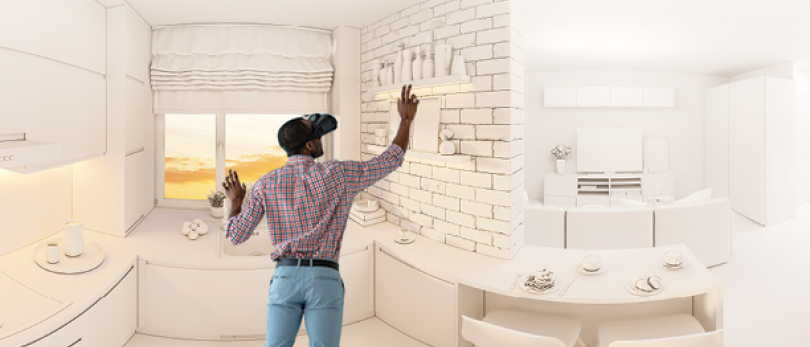Is virtual reality a boon for real estate or just more bells and whistles? It depends who you ask.
By Michelle Markelz
Virtual reality is becoming more accessible, but not all REALTORS® are convinced it works. Real estate is not immune from the e-commerce evolution and the changes in consumer behavior it has brought. These days, 87% of shoppers begin their product search on digital channels, according to research from Salesforce and Publicists, and homebuyers share the sentiment. The National Association of REALTORS® found that 44% of homebuyers start their property search on the internet.
Facing this reality, real estate professionals must find ways to make the digital homebuying and home selling experience as satisfying and comprehensive as the shopping experiences consumers appreciate from their favorite retailers. That means incorporating elements like 360-degree images, customization and immersive viewing—all made possible with virtual reality.
Once relegated to entertainment, virtual reality (VR) is now commonplace in a host of industries from healthcare and hospitality to retail and, yes, real estate. Though the term VR may conjure up images of bulky goggles unlocking computer-generated fantasy worlds, the technology has many more applications aimed at replicating reality, rather than creating an alternative one. In real estate, VR can generate a home tour with such detail that viewers feel they can almost achieve the same perspective as if they were to kneel on the floor to examine the grain of the hardwood in-person or float above the roof for a “dollhouse” view.
Virtual adds value in fast-moving markets
Like most new technology, VR has its early adopters and those who’d rather wait and see—its champions and its skeptics. One broker/owner who’s all-in with VR is Nick Solis, CRS, of One80 Realty in Brentwood, California. Solis has been using VR for about six years and says it is a great value to his clients looking to leave the high-priced San Francisco Bay Area for more affordable homes away from the city. The drive time to showings can be an hour each way, but with VR, buyers can get a real glimpse of the home and its features and fall in love with it without the commute.
“Traffic is fierce in the Bay Area,” Solis says. “A lot of buyers don’t feel it’s a good use of their time to drive an hour to view a property that they’ve only seen in photos. [Virtual tours] create the same opportunity for a buyer as a home visit. As a professional, it’s powerful because I’m showing great respect for their time and allowing the client to see the house on their own terms.”
Solis’ first VR tool was Matterport, a high-end provider of high-resolution virtual tours, but recently he’s been using a nimble competitor called Asteroom. According to Solis, both products generate 3D virtual home tours, but Matterport is more cost-prohibitive and requires longer production lead time. Whereas a Matterport tour takes about two hours to film and a business day to render, Asteroom tours can be generated in about half an hour with little sacrifice in quality, Solis says.
“If you have a newer iPhone, the resolution on those cameras is incredible, so there’s no discernible difference in quality [between Asteroom and Matterport tours]—they both create similar outcomes,” Solis says.
Matterport has announced plans to increase accessibility by launching its own smartphone-compatible solution in 2020.
Nicole Readdick, CRS, associate broker at Coldwell Banker Platinum Partners serves Kingsland, Georgia, and has used Matterport as well. She says that while the technology is flashy, the return on investment isn’t there for most properties. “In our market, I do not feel that virtual tours are the key to houses that sell,” Readdick says. She recalls one property that was uncommonly large, and the virtual tour was a nice visual aid, but she does not believe it contributed to the buyer’s decision.
Set the stage
Another way real estate professionals are using VR is virtual staging, enhancing real photo-graphs of properties with digitally inserted décor from furniture to art to fire.
PlanOmatic is the photography and virtual staging service preferred by Geena Becker, CRS, agent and team leader at William Raveis Real Estate serving the West Hartford, Connecticut, area. Virtual fire is a hot commodity, and PlanOmatic’s Pro Photo Package guarantees a fire in every fireplace. Becker has been using virtual staging for eight years and says the houses that benefit most from the technology are those with spacious rooms that can be hard to fill with a traditional furniture arrangement or those with too much of the homeowner’s character that could be off-putting for a buyer.
“I had a lake house with a giant living room off of an open kitchen,” Becker says. “I had them stage it as a living room with an eat-in kitchen. That sold in two days. On the houses that may be tough to sell visually, it is a tremendous tool.”
Becker has heard from naysayers, like a stager she worked with in the past who warned her that buyers may be let down when they visit a virtually staged house and find it empty or filled with the occupant’s furniture. But thus far, she has not encountered that issue. “I’ll put the virtual stage and the [empty room] next to it in the MLS, so the buyer will see what it could look like,” she says, which helps manage buyer expectations.
Janet Brophy, CRS, broker/owner of Home and Income Realty, serves the Tampa, Florida, area and prefers to show homebuyers undoctored photos of the properties that interest them. One of her clients, a personal injury attorney, saw a home that was virtually staged and upon visit-ing in-person described the experience as deceptive. “In my opinion, it totally misrepresented how the house appeared,” Brophy says. “You may get a lot of showing appointments, but you’re walking a fine line of upsetting buyers.”
The average cost to stage a house with physical furniture can start at $800 to $1,000 and accrue an additional $500 to $600 per month. PlanOmatic charges by the bundle of photos, but can be retained for a one-time fee as lowas $149 per home.
While the barrier to entry is coming down, VR is an additional cost that agents and brokers must consider fitting into their marketing budgets. Whether it makes the difference in a sale or is just nice to have available is still up for debate. Those looking to test the water may opt for solutions that require less investment in hardware, such as 3D cameras, and allow for flexible subscriptions that can be canceled at any time, rather than annual contracts.
Learn more! Take the webinar “Virtual and Augmented Reality in Real Estate.”








